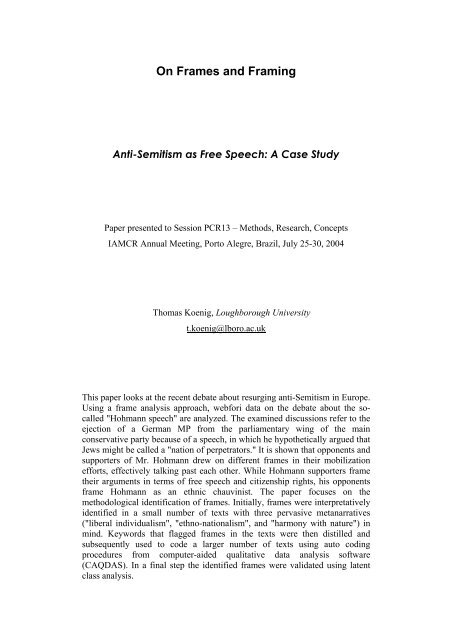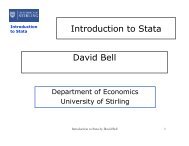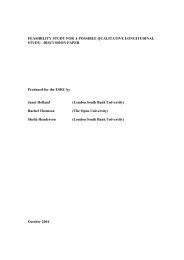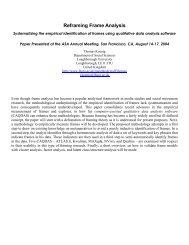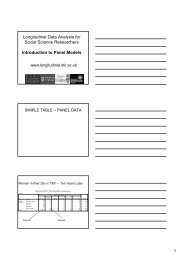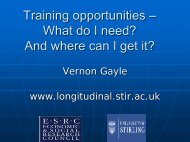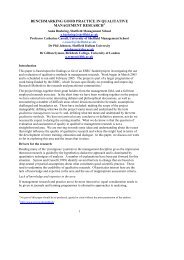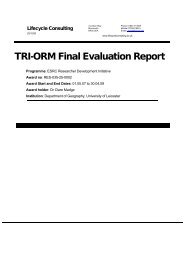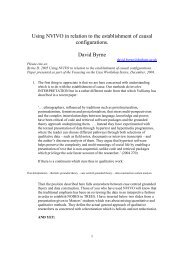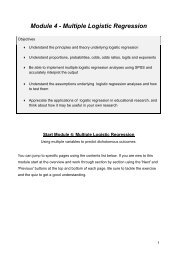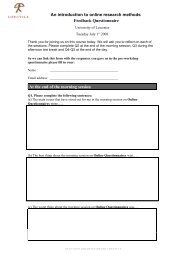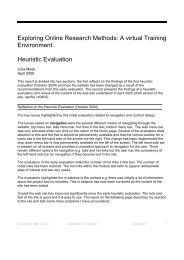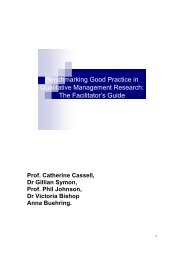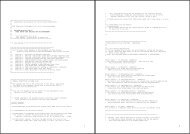You also want an ePaper? Increase the reach of your titles
YUMPU automatically turns print PDFs into web optimized ePapers that Google loves.
On Frames and Framing<br />
Anti-Semitism as Free Speech: A Case Study<br />
<strong>Paper</strong> presented to Session PCR13 – Methods, Research, Concepts<br />
IAMCR Annual Meeting, Porto Alegre, Brazil, July 25-30, 2004<br />
Thomas Koenig, Loughborough University<br />
t.koenig@lboro.ac.uk<br />
This paper looks at the recent debate about resurging anti-Semitism in Europe.<br />
Using a frame analysis approach, webfori data on the debate about the socalled<br />
"Hohmann speech" are analyzed. The examined discussions refer to the<br />
ejection of a German MP from the parliamentary wing of the main<br />
conservative party because of a speech, in which he hypothetically argued that<br />
Jews might be called a "nation of perpetrators." It is shown that opponents and<br />
supporters of Mr. Hohmann drew on different frames in their mobilization<br />
efforts, effectively talking past each other. While Hohmann supporters frame<br />
their arguments in terms of free speech and citizenship rights, his opponents<br />
frame Hohmann as an ethnic chauvinist. The paper focuses on the<br />
methodological identification of frames. Initially, frames were interpretatively<br />
identified in a small number of texts with three pervasive metanarratives<br />
("liberal individualism", "ethno-nationalism", and "harmony with nature") in<br />
mind. Keywords that flagged frames in the texts were then distilled and<br />
subsequently used to code a larger number of texts using auto coding<br />
procedures from computer-aided qualitative data analysis software<br />
(CAQDAS). In a final step the identified frames were validated using latent<br />
class analysis.
Anti-Semitism as Free Speech: A Case Study<br />
This paper presents on the case of a recent debate about anti-Semitism in Germany, a novel<br />
and systematic methodology to identify frames and validate, compare, or falsify different<br />
framing models.<br />
After a delineation of the theoretical approach to framing theory, the focus of the paper<br />
will be on the methodological identification of frames. Initially, frames were interpretatively<br />
identified in a small number of texts with three pervasive metanarratives ("liberal<br />
individualism," "ethno-nationalism," and "harmony with nature") in mind. Keywords that<br />
flagged frames in the texts were then distilled. These keywords were subsequently used to<br />
code further texts using auto coding procedures from computer-aided qualitative data analysis<br />
software (CAQDAS). In a final step the identified frames were validated using latent class<br />
analysis.<br />
Framing Theory<br />
Frame analysis is en vogue (Meyer 1999: 85; Reese 2001: 7; Benford and Snow 2000: 611f),<br />
although it was initially predicted to become a niche method at best. One Contemporary<br />
Sociology reviewer complained that Frame Analysis is cumbersome to read (Davis 1975:<br />
603), the other one wondered, if an adequate systematization of frame analysis would be<br />
feasible (Gamson 1975: 605).<br />
Probably the single most important factor for the success of Goffman's frame analysis is<br />
therefore its unorthodox application. Frame analysis is no longer Goffman's frame analysis,<br />
but is frequently only loosely connected to the original formulation. Notwithstanding the<br />
recurrent symbolic nods to Goffman, today's "frame analysis" spans a number of disparate<br />
approaches (D'Angelo 2002; Fisher 1997; Maher 2001: 81f; Scheufele 1999: 103, 118), some<br />
of which are even incompatible with each other (Scheufele 1999: 118), While not excluding<br />
the possibility of fruitful interaction between the heterogeneous frame analyses (D'Angelo<br />
2002: 883), conceptual parsimony necessitates the clarification of the framing concept for<br />
present purposes.<br />
This is not the place to overview the wide range of approaches that have been subsumed<br />
under the heading of frame analysis, a task that others (Benford and Snow 2000; D'Angelo<br />
2002; Scheufele 1999) have already accomplished. Instead, I would like to merge at this<br />
1
Thomas Koenig: Framing Anti-Semitism as Free Speech 2<br />
juncture certain brands of framing approaches to a more specific theoretical framework. In<br />
his initial and widely quoted definition, Goffman characterized frames as follows:<br />
“I assume that definitions of a situation are built up in accordance with<br />
principals of organization which govern events […] and our subjective<br />
involvement in them; frame is the word I use to refer to such of these basic<br />
elements as I am able to identify” (Goffman 1974: 10f)<br />
In other words, frames are basic cognitive structures which guide the perception and<br />
representation of reality. On the whole, frames are not consciously manufactured but are<br />
unconsciously adopted in the course of communicative processes. On a very banal level,<br />
frames structure, which parts of reality become noticed.<br />
Todd Gitlin has summarized these frame elements most eloquently in his widely quoted<br />
(e.g., Miller 1997: 367; Miller and Riechert 2001b: 115) elaboration of the frame concept:<br />
"Frames are principles of selection, emphasis and presentation composed of<br />
little tacit theories about what exists, what happens, and what matters." (Gitlin<br />
1980: 6)<br />
While it is hard to improve theoretically on this definition, the trouble starts, when it comes to<br />
the identification and measurement of frames. Precisely because frames consist of tacit rather<br />
than overt conjectures, notorious difficulties to empirically identify frames arise (Maher<br />
2001: 84).<br />
The difficulty of measuring latent frames could partially explain the gradual theoretical<br />
shift towards a conceptualization of frames as being more actively adopted and<br />
manufactured. Particularly in media studies, it has become commonplace to treat the choice<br />
of frames as a more or less deliberate process. Entman's famous definition of frames led the<br />
way. For Entman,<br />
“[t]o frame is to select some aspects of a perceived reality and make them<br />
more salient in a communicating text, in such a way as to promote a particular<br />
problem definition, causal interpretation, moral evaluation, and/or treatment<br />
recommendation.” (Entman 1993: 52)<br />
Notice the shift towards active selection of frames, a conception that has become dominant in<br />
media studies. While indeed not agreeing with Entman on much else, D'Angelo (2002: 873)<br />
likewise treats frames as consciously pitched powerful discursive cues. Tankard (2001: 97)<br />
moves even beyond the mere conscious selection of frames, suggesting that journalists at<br />
times circulate frames to deceive their audiences. Reese (2001: 7) goes furthest in the<br />
direction of conscious framing suggesting that framing always implies an active process.<br />
Consequently, he demands that the analysts "should ask how much 'framing' is going on"<br />
(ibid., 13). In a Goffmanian framework, such a question would have been non-sensical, since
Thomas Koenig: Framing Anti-Semitism as Free Speech 3<br />
framing is an innate property of all social processes, not only those most consciously<br />
manufactured. This paper sticks more to the original approach and thus treats frames as<br />
"conceptual scaffolding" (Snow and Benford 1988: 213).<br />
Methodology<br />
Since framing became a popular approach in the late 1980s, an extensive and disparate<br />
laundry list of frames has emerged in the literature (Benford 1997: 414). This disparity of<br />
frames leaves one wonder, whether anything can be framed as a frame. Unfortunately, many<br />
studies leave the reader in the dark about the actual process of empirical frame detection.<br />
Even otherwise exceptionally well argued studies laconically describe the frame<br />
identification process in a footnote with "[f]rames were analyzed from the actual language of<br />
the reported claim (direct and reported speech)" (Statham and Mynott 2002: 10, Fn. 6). In<br />
some cases, at least the measurement model for frames is clarified. In these cases the reader is<br />
presented with a list of more or less parsimoniously identifiable frame terms, "attributes" or<br />
"devices," which were used as manifest indicators for the identification of frames (e.g., Ferree<br />
et al. 2002; Koella 2003; Semetko and Valkenburg 2000; Ullrich 1998; Semetko and<br />
Valkenburg 2000; Ullrich 1998). By making their entire coding scheme available online,<br />
Ferree et al. (2002) are in this respect the trailblazers for a new kind of transparency that has<br />
been made possible by the new digital technologies. 1 While increased transparency and<br />
accountability certainly render framing research more credible, they still do not solve the<br />
problem of the missing systemization of frame construction. We thus remain heavily so<br />
dependent on the creativity of individual scholars (Maher 2001: 84), that it has been alleged<br />
that frames are merely constructed through "researcher fiat" (Tankard et al. 1991: 5; Tankard<br />
2001: 98).<br />
To counter these objections, the frame identification process should be made more visible<br />
and systematic. A first step towards the latter direction is the construction of a frame<br />
taxonomy, distinguishing structural schemes ("generic frames") from frames that focus more<br />
on content (Benford 1997: 413; Rogers, Hart, and Dearing 1997).<br />
With respect to media framings, four generic frames have frequently been identified,<br />
namly<br />
1<br />
http://www.ssc.wisc.edu/abortionstudy/, last accessed: October 6, 2003.
Thomas Koenig: Framing Anti-Semitism as Free Speech 4<br />
- conflict frame (Rogers et al. 1997; Neuman, Just, and Crigler 1992: 61f; Price,<br />
Tewksbury, and Powers 1997: 484; Semetko and Valkenburg 2000: 95), 2<br />
- human interest frame (Price et al. 1997: 484; Semetko and Valkenburg 2000: 95f),<br />
- economic interests frame (Triandafyllidou and Fotiou 1998: 4.19; Price et al.<br />
1997: 484; Schwenken 2003: 5),<br />
- moralization frame (Triandafyllidou and Fotiou 1998: 4.1; Ferree et al. 2002:<br />
107f; Neuman et al. 1992: 75; Semetko and Valkenburg 2000: 96)<br />
Within the list of content frames, we can further distinguish between so-called "master<br />
frames" or "metanarratives" that<br />
(1) are so pervasive that they can be used in almost any situation, and<br />
(2) posses a superior credibility, in that it has moved beyond empirical<br />
scrutiny.<br />
Three master frames surface repeatedly in the literature, i.e. the ethno-nationalist frame<br />
(Billig 1995; Brubaker and Laitin 1998: 428; Eder 1995: 4; Eder and Schmidtke 1998;<br />
Greenfeld 1999: 39; Statham and Mynott 2002: 13), the liberal-individualist citizenship<br />
frame (Berger 1971: 97f; Eder 1995: 4 McAdam 1996: 347; Somers 1995; Statham and<br />
Mynott 2002: 13) and the harmony with nature frame (Eder 1996: 191; Gamson 1992: 136).<br />
With these clarifications and distinctions in hand, I will now propose a fairly systematic<br />
approach to identify content frames in textual data. Since the methodology rests on the<br />
selection of keywords and key phrases, it is less suited to identify structural frames such as<br />
the conflict frame, as these frames usually become manifest in the structure, and less in the<br />
wording of a speech.<br />
Identifying Frames in Textual Data<br />
Framing in the sense outlined above is a theoretically demanding concept, but – or, rather, as<br />
a result – it has proven elusive to measure (Maher 2001: 84). Even though on a conceptual<br />
level, frames, more often than not, are latent, read: not spelled out in their entirety, it seems<br />
reasonable to assume that parts of frames become manifest in speech. If, say, a speaker has<br />
adopted or keyed an ethno-nationalist frame, i.e., the conception that quasi-primordial<br />
culturally fairly homogenous groups of people can be delineated (and probably should be<br />
granted some degree of self rule), we would expect this speaker to refer some components of<br />
that frame in speech. She or he might, for instance speak about peoples, might allude to some<br />
historical continuities, might refer to specific (ethnic) nations, such as "the Dutch," etc. These<br />
2<br />
Implicitly, the "balancing frame" (Ferree et al. 2002: 107) is part of the conflict frame.
Thomas Koenig: Framing Anti-Semitism as Free Speech 5<br />
speech figures in turn can be identified by keywords (Entman 1993: 53; Triandafyllidou and<br />
Fotiou 1998: 3.7; Miller and Riechert 2001a: 61ff), which can help to empirically identify<br />
frames in large corpora of data.<br />
The first task in the empirical investigation of frames thus becomes the detection of these<br />
keywords. As keywords are manifest, this is a much simpler task than the identification of<br />
frames themselves. It has even been suggested to generate these keywords automatically,<br />
simply by mapping the most frequently words or strings within the data (Koella 2003: 7;<br />
Miller and Riechert 2001a: 70; Miller and Riechert 1994).<br />
While avoiding researcher bias, this methods unfortunately creates three new problems. To<br />
begin with, it starts out with exactly a researcher fiat, that is in deciding by convention on the<br />
optimal number of eigenvectors (Miller and Riechert 2001b: 116). This decision might sound<br />
more "objective," as a number can be pegged onto, but that number is just as arbitrary as the<br />
decision on frames. Moreover, the procedure is deeply positivist, assuming that concepts<br />
should arise unmediated from the data. But even within a positivist logic, most statistical tests<br />
are based on a priori probabilities. By basing the decision in the choice of keywords on ex<br />
post covariances, these tests become meaningless. While this problem could be circumvented<br />
through a split sample, an even more severe problem is that empirically identified keywords<br />
clearly cannot be interpreted as indicator of meaningful frames. Miller & Riechert (1994), for<br />
instance, found besides "environmental," "any," and "major" to be identifiers of the<br />
"environmental protection" frame. It seems obvious that these are no meaningful framing<br />
terms. Indeed, Koella (2002: 8), who most closely follows Miller and Riechert, deviates in<br />
this point, wryly noting that "each set of frame terms was reviewed in context." This<br />
proceeding, of course, reintroduces research fiat through the back door.<br />
Frequency counts might thus hint at possible keywords, but in the end an interpretative<br />
identification of relevant keywords seems to be the more appropriate and more common route<br />
(Andsager, Austin, and Pinkleton 2001: 129; Tankard 2001: 103; Tedesco 2001: 2053, more<br />
technically centered: Miller 1997: 369). Reading or listening over a reasonable amount of<br />
data, framing researcher should hermeneutically uncover frames and their corresponding<br />
keywords. The three master frames mentioned above could help the interpretation of data in<br />
this respect, as these frames are likely to surface in any communicative processes in<br />
modernity.
Thomas Koenig: Framing Anti-Semitism as Free Speech 7<br />
Currently, hierarchical cluster analysis seems to be the most popular method for statistical<br />
validation of frames. That is, if you can speak of "popular", when merely a handful of<br />
references exist (Dyer 1994; Koella 2003; Landmann and Züll 2004: 120; Miller 1997; Miller<br />
and Riechert 1994; Miller and Riechert 2001b; Miller and Riechert 2001a). The reason for its<br />
relative popularity is probably the existence of a computer program – VBPro 7 – that is<br />
specifically written for this type of analysis. The reason for its relative unpopularity might be<br />
the very same program, that is its command line DOS interface. There are a few other<br />
problems with this methodology, though. To begin with, it requires specific chunks of data –<br />
documents with around 1,000 words –to perform best (Miller 1997: 369). While this problem<br />
could be alleviated by slicing or aggregating data appropriately, the a general problem of all<br />
cluster analyses – be it k-means or hierarchical – cannot be circumvented, namely that it does<br />
not offer any real goodness of fit tests (Aldenderfer and Blashfield 1984), which in turn<br />
makes it impossible to choose an optimum number of clusters on an empirical basis (Miller<br />
and Riechert 2001b: 116; Trochim and Hover 2003). That means that any number of frames<br />
could be posited throughout the texts, without any possibility to falsify any frame model,<br />
which, once again would return us to researcher fiat. On top, hierarchical cluster analysis<br />
assumes texts to belong to either one or the other frame. But it is entirely reasonable, and<br />
even likely, that speakers use any number of frames in a given text. In fact, many speakers<br />
actively engage in frame alignment processes such as frame bridging (Snow et al. 1986),<br />
which presuppose the existence of more than one frame in a text. Moreover, cluster analysis<br />
assumes a direct measuring model, but as has been discussed in the theoretical part of this<br />
paper, keywords are only indicators of latent frames. Altogether, hierarchical cluster analysis,<br />
thus, seems only ill suited for frame model validations.<br />
Factor Analysis seems to avoid all the shortcomings of cluster analysis. It knows wellestablished<br />
goodness of fit criteria, it assumes a measurement model that does justice to the<br />
latency of frames, and it can decide on an empirical basis, which frame model is more<br />
adequate. Yet, to date we know only of one nascent attempt to use frame analysis in framing<br />
studies (Risse and Van de Steeg 2003). While the headway made compared to cluster<br />
analysis is considerable, it seems puzzling that the authors do not even discuss the violation<br />
of the scale level assumptions of factor analysis, even though it has been shown that this<br />
violation can seriously affect the substantial results (Magidson and Vermunt 2004).<br />
7<br />
http://mmmiller.com/vbpro/vbpro.html, last accessed: December 15, 2003.
Thomas Koenig: Framing Anti-Semitism as Free Speech 8<br />
In contrast, latent class analysis exhibits all required features factor analysis offers, but at<br />
the same time does not contain the same shortcomings, making it very well-suited for the<br />
analysis of quasi-idealtypical concepts (Hagenaars and Halman 1989) such as frames. It<br />
should seem therefore straightforward to introduce it into frame analysis studies. Although<br />
the methodological principles of latent class analysis have been already developed in the<br />
fifties (Lazarsfeld 1950; Hagenaars 1993: 20), it has remained an esoteric statistical method<br />
for many social scientists (Reunanen and Suikkanen 1999: 3). 8<br />
In comparison to cluster analysis, latent class analysis delivers more unequivocal results,<br />
as it allows for a number of well-developed goodness of fit measures. And while it shares<br />
with factor analysis the virtue of operating with latent variables, it does not contain the caveat<br />
of requiring hard to come by interval scaled data. We therefore choose to validate our frame<br />
models with latent class analysis.<br />
Data: The Hohmann Case<br />
We tested the outlined methodology by identifying frames in a recent debate on the treatment<br />
of anti-Semitism in the public sphere in Germany.<br />
In November 2003, the exclusion of a Conservative backbencher MP Martin Hohmann<br />
from the parliamentary faction of the main German conservative party, triggered a lively<br />
debate about the question on the legitimacy of his exclusion against his expressed will.<br />
The debate was triggered by a speech Hohmann gave on the German National holiday in<br />
his electoral district. The core argument of the speech was that Germans are unduly branded<br />
as Tätervolk, a "people of perpetrators." Drawing on the writings of Henry Ford and a<br />
hitherto unknown historian with virtually no academic recognition, Hohmann had claimed<br />
using the standards of those, who consider Germans a Tätervolk, Jews could equally well be<br />
portrayed as Tätervolk, because the latter participated overproportionately in the Russian<br />
Revolution and the crimes of Stalinism.<br />
Initially, the speech had no repercussions for Hohmann. The local paper did report on the<br />
speech, but omitted its anti-Semitic overtones. It took a letter from an American Jew, who<br />
8<br />
Basically, latent class analysis can be considered the equivalent of factor analysis for ordinally and<br />
nominally scaled variables (McCutcheon 1987: 7). It examines, if a set of observable indicators can<br />
meaningfully be projected onto a smaller set of latent, that is, unobservable classes. Most important theoretical<br />
concepts, among them frames, do not translate straightforwardly into easily empirically observable, that is:<br />
measurable, indicators. Latent class analysis that expressly works with latent, read: unobservable, variables<br />
(Lazarsfeld 1950: 363) is therefore in the analysis of frames superior to other log-linear models that operate<br />
exclusively with observable data.
Thomas Koenig: Framing Anti-Semitism as Free Speech 9<br />
discovered the speech manuscript in the internet, to alert the national German media. Once<br />
the case was made public to a nationwide audience, a short debate in the traditional mass<br />
media ensued, which almost unanimously branded the speech as anti-Semitic. The coverage<br />
eventually resulted in Hohmann's expulsion from the CDU ranks, first of its parliamentary<br />
section, and a few months later also from the party itself. 9 While most journalists and<br />
nationwide known party politicians debunked the Anti-Semitism evident from the speech,<br />
lower party officials, and a number of members of the general public interviewed by the mass<br />
media denied an expressed anti-Semitic background of the speech, 10 even after it's main<br />
intellectual origins were discussed at length.<br />
Although the anti-Semitic core of the speech is evident to the social scientist schooled<br />
minimally in theories of anti-Semitism, both the absence of an adequate initial reaction to the<br />
speech and the vehement denial of its existence even after a weeklong public debate, suggests<br />
that large parts of the general public have framed the debate in different terms.<br />
We gathered data from a web forum offered by the national party organization of the<br />
CDU, 11 in an attempt to model effectively, how Hohmann opponents and supporters framed<br />
their arguments. Over a two-months period, 2,626 postings were collected from the forum<br />
and subsequently analyzed using the methodology outlined above. 12 As will be shown,<br />
supporters and opponents drew frequently on different frames, effectively talking past each<br />
other. While Hohmann supporters frame their arguments in terms of free speech and<br />
citizenship rights, his opponents frame Hohmann as an ethnic chauvinist.<br />
Results<br />
With this methodology at hand, and the three master frames in mind, we initially identified<br />
five potential substantive frames within the data.<br />
On the structural level, the Hohmann debate is governed by the conflict frame, but the<br />
different content framings picture the conflict as one between very different protagonists: The<br />
9<br />
"Hohmann will gegen Ausschluss vorgehen ," Süddeutsche Zeitung, July 20, 2004,<br />
http://sueddeutsche.de/deutschland/artikel/640/35605/, last accessed: July 20, 2004.<br />
10 "Mitleid, Bestürzung und Ratlosigkeit," Fuldaer Zeitung, November 15, 2003,<br />
http://www.fuldaerzeitung.de/sixcms/detail.php?template=fz_meldung&id=75456, last accessed: July 20, 2004.<br />
11 http://www.cdu.de/forum/thema4/message.html, last accessed December 31, 2003.<br />
12 We used MAXqda (http://www.maxqda.com/, last accessed: July 20, 2004) to code the data, and Latent<br />
GOLD (http://www.statisticalinnovations.com/products/latentgold.html, last accessed: July 20, 2004) to conduct<br />
the latent class analysis of the coding matrix.
Thomas Koenig: Framing Anti-Semitism as Free Speech 10<br />
political right versus the political left; anti-Semites versus anti-Fascists, or the elites versus<br />
the common citizenry.<br />
Content Frames<br />
Two key on the liberal-individualist master frame, claiming the violation of freedom of<br />
speech rights and/or the limitation of the discursive space by political elites. A third<br />
hypothesized frame keys on both ethno-nationalist and liberal-individualist frames,<br />
attributing the restriction of freedom of speech to an undue Jewish influence. Two further<br />
frames key on ethnonationalist themes, demanding a "normalization" of German ethnicity,<br />
the other insisting on Hohmann being an adamant anti-Semite. Table 1 displays the<br />
keywords, with which we identified the frames.<br />
Freedom of Speech<br />
By far the most frequent argument cited by Hohmann supporters is the idea, that, even if his<br />
speech was indefensible, his freedom of speech rights were violated by his ejection from the<br />
party faction. A typical example of this frame reads as follows:<br />
"Das Recht der freien Meinungsäußerung läßt sich nicht nach gewünschter<br />
politischer Ausrichtung, nach parteipolitischen Strömungen, nach politischem<br />
Standort oder durch Parteipolitiker interpretieren.<br />
Von daher ist der Ausschluß von Hohmann aus der Bundestagsfraktion der<br />
CDU/CSU sogar grundgesetzwidrig, erfolgt unter dem Bruch des<br />
Grundgesetzes." 13<br />
It does not matter for our purposes here that from a legal standpoint, this is of course, not the<br />
case, and, indeed, using legal arguments the expulsion of Hohmann could be framed as a case<br />
of freedom of speech and associational freedom. What is interesting here is, that rarely, if<br />
ever this point is made by Hohmann adversaries. Instead, persons agreeing with his expulsion<br />
usually do so on the grounds that the restriction of freedom of speech is legitimized by<br />
Hohmann's anti-Semitism.<br />
13 "Freedom of speech rights cannot be interpreted according to one's desired political preferences, according<br />
to party politics, according to one's political standpoint or by party politicians. Therefore , Hohmann's expulsion<br />
from the party ranks, even breaches the Constitution."
Thomas Koenig: Framing Anti-Semitism as Free Speech 11<br />
Master<br />
Frame<br />
Liberal<br />
Individualist<br />
Citizenship<br />
Rights<br />
Frame Fuzzy Lexemes Lemmata Exclusions<br />
freedom of<br />
speech<br />
rebuke of<br />
elitism<br />
freedom of speech<br />
repression of<br />
censorship<br />
taboo<br />
totalitarian<br />
political correctness<br />
Constitution<br />
(Basic Law)<br />
second chance<br />
witch hunt<br />
inciting<br />
metaphor "to keep<br />
cooking"<br />
Basis<br />
we, the common<br />
citizenry<br />
Christian Democrat<br />
leadership<br />
Andersdenkende, -n<br />
Freiheit<br />
Freiheiten<br />
Meinung, -en<br />
Meinungsfreiheit, -en<br />
Meinungsäußerung, -en<br />
Meinungsäusserung, -en<br />
repressiv, -e, -en, -er<br />
Repressivität<br />
unterdrücken, -t, -te, -ten<br />
Unterdrückung<br />
Maulkorb<br />
mündig<br />
Sanktionen<br />
Zensur<br />
Zensor, -en, -s<br />
zensiert, -e, -er, -en<br />
zensieren<br />
Tabu, -isierung, isierungen<br />
tabuisieren, -iert, -ierte<br />
totalitär, -e, -en, -er<br />
Totalitarismus<br />
Berufsverbot<br />
Berufsbetroffene, -r, -m, -n<br />
berufsbetroffen, -e, -en, -em<br />
Gutmensch, -en<br />
berufsmäßigen<br />
Vergangenheitsbewältigern<br />
Berufsdreckschleudern<br />
PC<br />
peeßee<br />
politisch, -e, -en, -er<br />
korrekt, -e, -er, -en<br />
Korrektheit<br />
political, -ly<br />
correct<br />
correctness<br />
Grundgesetz<br />
Grundrecht<br />
Grundrechte<br />
Verfassung<br />
Bürgerrecht, -e, -en<br />
Artikel<br />
2. Chance<br />
2.Chance<br />
zweite Chance<br />
2 Chancen<br />
zwei Chancen<br />
Hexenjagd, -en<br />
Hexenverfolgung, -en<br />
Hexenverbrennung, -en<br />
Hexe, -n<br />
Inquisition<br />
Hetzen<br />
Hetzerei, -en<br />
hetzerisch, -e, -er, -en<br />
Hatz<br />
Kochen<br />
kocht, -en<br />
hochkochen<br />
Basis<br />
Parteibasis<br />
wir<br />
uns, -er, -ere, -ren, -rem<br />
CDU-Führung<br />
Partei-Führung<br />
Parteiführung<br />
Merkel, -s<br />
Bosbach, -s<br />
Stoiber, -s<br />
Junge Freiheit<br />
Berufsverbot<br />
Hexentanz
Thomas Koenig: Framing Anti-Semitism as Free Speech 12<br />
Ethno-<br />
Nationalism<br />
undue Jewish<br />
influence<br />
normalization<br />
of German<br />
ethnicity<br />
Anti-Semitism<br />
Media<br />
Social Sciences<br />
Zentralrat der Juden<br />
American Jews<br />
"Holocaust<br />
Industry"<br />
Germanness<br />
we, the ethnic<br />
Germans<br />
patriotism<br />
collective guilt<br />
repentance<br />
constant reminder<br />
German<br />
guilt<br />
normal<br />
pride<br />
anti-Semitism<br />
Jews/Jewish/Jewry<br />
religion<br />
Nazis<br />
Koch, -s<br />
Medien<br />
Presse<br />
Spiegel<br />
Stern<br />
Journalist, -en<br />
Soziologie<br />
Soziologen<br />
Benz<br />
Zentralrat<br />
ZdJ<br />
Friedman, -s<br />
Spiegel, -s<br />
Berufsjuden<br />
amerikanische Jüdin<br />
Holocaust-Industrie<br />
Holocaustindustrie<br />
Finkelstein, -s<br />
Deutschland<br />
deutsch, -e, -er, -es, -en<br />
Deutsche, -er, -es, -en<br />
andere Länder<br />
anderen Ländern<br />
wir<br />
uns, -er, -ere, -ren, -rem<br />
Patriot, -en<br />
Patriotismus<br />
patriotisch, -er, -em, -en<br />
Kollektivschuld<br />
kollektiv schuld, -ig<br />
Büßer<br />
permanent, -e, -en, -er<br />
ewig, -e, -er, -en<br />
Erinnerung<br />
erinnern<br />
Deutschland<br />
deutsch, -e, -er, -es, -en<br />
Deutsche, -er, -es, -en<br />
Schuld<br />
schuldig, -e, -er, -en<br />
Schuldige, -er, -en<br />
normal, -e, -er<br />
Normales<br />
Normalisierung<br />
stolz, -e, -er<br />
Stolz, -es<br />
Nationalstolz, -es<br />
Antisemit<br />
Anti-Semit<br />
Antisemit, -en<br />
Anti-Semiten<br />
Möllemann, -s<br />
Karsli, -s<br />
Walser, -s<br />
Jenninger, -s<br />
Jude, -n<br />
jüdisch, -e, -er<br />
Religion<br />
braun<br />
Nazi, -s<br />
NSDAP<br />
Nationalsozialist, -en<br />
nationalsozialistische, -r ,-n, -m<br />
Mercedes-Benz<br />
Daimler-Benz<br />
Der Spiegel<br />
Im Spiegel<br />
Spiegel Artikel<br />
Table 1 Framing Devices (search terms set in boldface, homonyms in orange, conditional searches in olive,<br />
interpretative codings in purple)
Thomas Koenig: Framing Anti-Semitism as Free Speech 13<br />
Elitism<br />
A second frame that is closely related and thus co-occurs frequently with the freedom of<br />
speech frame is the idea that political speech is directed and curtailed by the "elites," namely<br />
politicians, intellectuals, and the press. Frequently, Hohmann's expulsion is considered as an<br />
act of "political correctness," brought about by an elite out of touch with the common<br />
citizenry:<br />
"Stattdessen wird alles mögliche [in die Rede] hineininterpretiert und zwar<br />
von Meinungsmachern, die daran ein Interesse haben, dass so ein Käse dem<br />
Volk als hochwichtig vorgegaukelt wird" 14<br />
People, who dispute this framing, are frequently derided as Gutmenschen – do-gooders – who<br />
support authoritarianism, which limit the debate, effectively itself an attempt to limit the<br />
debate by tabooing any reference to everyday anti-Semitism (Johnson and Suhr 2003).<br />
Jewish Conspiracy<br />
A special case of the elitism frame evokes anti-Semitic conspiracy theories. In this scenario,<br />
the driving force behind the presumed restriction of the discursive space is driven by Jewish<br />
organizations:<br />
"Fakt ist, dass der ZDJ die moralisch (und somit politisch) die höchste Macht<br />
im Land ist." 15<br />
This frame combines ethno-nationalist elements (considering Jews a primordial ethnicity with<br />
a common interest and distinct from the German nation) with the liberal idea that Jews with<br />
their superior power obliterate the equality of citizens. Besides the German Jewish Council,<br />
American Jewish diaspora organizations and the state of Israel and its representatives are<br />
considered the major adversaries in this frame.<br />
All three frames, which posit a politically forged limitation of the public discourse, cooccur<br />
with each other.<br />
"Wenn man in diesem Land nicht die Wahrheit sagen darf, diktiert von einer<br />
Minderheit (Medien, Zentralrat und linke Gutmenschen), dann gibt es keinen<br />
Grund, sich für diesen Staat/dieses System zu engagieren." 16<br />
14 "Instead, all sorts of things are interpreted [into the Speech] and it is done so by opinion leaders, who have a<br />
vested interest to sell such crap to the people."<br />
15 "It's a fact that the German Jewish Coucil is morally and therefore politically the highest power in the<br />
country."<br />
16 "If you cannot tell the truth in this country, [as] dictated by a minority (media, German Jewish Association,<br />
and leftist do-gooders), then there is no reason to become involved in this state/system."
Thomas Koenig: Framing Anti-Semitism as Free Speech 14<br />
Normalization of German Ethnicity<br />
Hohmann supporters that do not necessarily adopt an elitist stance, attribute the expulsion of<br />
Hohmann to a "pathology" in German ethnicity. This frame posits that due the Holocaust,<br />
Germans for long have had problems to come to terms with their ethnicity:<br />
"Das Juden im 3. Reich umgebracht wurden ist als äußerst tragisch zu<br />
bewerten und wird wohl auch von keinem vernünftigen Menschen bestritten.<br />
Es stellt sich aber die Frage, warum soll nach nun 50 Jahren kein normales<br />
Verhältnis zu den Menschen jüdischen Glaubens entstehen?" 17<br />
Anti-Semitism<br />
Those persons, who agree with Hohmann's expulsion, usually only contend with the latter<br />
framing, but ignore freedom of speech and elitism arguments, as they focus on Hohmann's<br />
anti-Semitism, which overrides any freedom-of-speech concerns. In some respect, this is the<br />
counter frame to the normalization framing, as it rejects any kind of normalization of German<br />
ethnicity along the lines of its disconnection from the Holocaust.<br />
"Die 'Argumentation' von Hohmann basiert unverzichtbar auf Antisemitismus<br />
und einer Verharmlosung des Holocausts." 18<br />
What is interesting in this type of framing, is that it frequently denounces the association of<br />
Jews with the word Tätervolk, but it hardly ever spells out the historical misconstructions and<br />
inaccuracies that run through Hohmann's argument. Instead, in this framing, anti-Semitism is<br />
deliberately put forward by decided anti-Semites, who have a close affiliation with Nazism,<br />
glossing over both hegemonic elements of anti-Semitism and the implicit racist notion of<br />
considering Jews as a Volk distinct from Germans.<br />
How many frames?<br />
From our interpretation, we thus found five frames in the data. But, if our operationalization<br />
was correct, do the data support our model? Table 2 shows that they do so with a twist. After<br />
validating the one-dimensionality of each of the five frame cluster with latent class analysis, 19<br />
a latent class analysis of those texts, which contained at least two of our keywords shows that<br />
17 "That Jews have been killed in the Third Reich is to be appraised as a tragedy and it will not be disputed by<br />
rational persons. But the question becomes, why after 50 years a normal relationship with people of Jewish<br />
creed can evolve."<br />
18 "Hohmann's 'argument' basis inherently in anti-Semitism and a belittling of the Holocaust."<br />
19 All keyword groups yielded the lowest BIC in two-cluster models, which reflects the idea, that a frame was<br />
either present or not.
Thomas Koenig: Framing Anti-Semitism as Free Speech 15<br />
these cluster fit best in a 3-cluster model, while the four-cluster model comes in a close<br />
second, yielding a Bayesian Information Criterion (BIC) that is worse only by 6.<br />
∆ BIC to model with one cluster less Classification Errors<br />
1-Cluster n/a 0<br />
2-Cluster -274.4 0.027<br />
3-Cluster -83.6 0.050<br />
4-Cluster 6.0 0.136<br />
5-Cluster 162.9 0.172<br />
6-Cluster 188.9 0.174<br />
Table 2 Model Fit with respect to Number of Frames<br />
Figure 1 shows that the conflict between presumed elites and the common citizenry is by far<br />
the most dominant theme, receiving almost three times as much attention than the two<br />
frames, which are not concerned with elite issues.<br />
1<br />
0.9<br />
0.8<br />
0.7<br />
0.6<br />
0.5<br />
0.4<br />
0.3<br />
0.2<br />
0.1<br />
0<br />
freedom of speech elitism "jewish conspiracy" anti-Semitism "normalization" of Germanness<br />
Figure 1 Mean Frequency of keyword terms per posting<br />
On inspection of the keyword probabilities in the clusters of the three-class model, we found<br />
that most postings (75%) would fairly evenly refer all frames, but there are two fairly welldefined<br />
clusters. Looking at Table 3, which displays the standardized relative class<br />
probabilities, i.e. the cluster probability divided by the average probability a term would show<br />
up in the data, we find that Cluster 2 is characterized by an above average of freedom of<br />
speech figures, followed by an about average of freedom of speech figures. That means that a<br />
substantial minority (15%) of speakers framed the conflict almost purely in terms of freedom<br />
of speech rights, which they saw endangered by the actions of a political elite. These speakers
Thomas Koenig: Framing Anti-Semitism as Free Speech 16<br />
were unfazed by allegations of anti-Semitism and rarely demanded the "normalization" of<br />
German ethnicity. They also were not being denounced of anti-Semitism themselves, nor was<br />
there any other substantial challenge to there framing, which effectively had no counter<br />
framing.<br />
The third cluster an smallest cluster represents the conflict between the openly anti-<br />
Semitic frames and the anti-Fascist, who debunk them. Persons, who make no bones about<br />
their anti-Semitic ideas also support a "normalization" of Germanness and unsurprisingly<br />
become debunked because of their open anti-Semitism.
Thomas Koenig: Framing Anti-Semitism as Free Speech 17<br />
Cluster Size 0.75 0.15 0.11<br />
Freedom of Speech<br />
repression 0.90 1.44 0.66<br />
brainwashing 0.42 2.58 0.00<br />
totalitarianism 0.82 1.45 0.73<br />
GDR 0.92 1.49 0.59<br />
taboo 1.17 1.07 0.76<br />
censorship 0.76 1.52 0.72<br />
mobbing 3.00 0.00 0.00<br />
freedom of speech 0.05 2.44 0.51<br />
opinion 1.09 1.20 0.71<br />
Basic Law (constitution) 0.72 1.64 0.65<br />
dissenters 0.73 1.86 0.42<br />
Elitism<br />
feigning (heucheln) 1.69 0.00 1.31<br />
p.c. 1.09 1.04 0.86<br />
second chance 1.27 0.92 0.81<br />
badgering (hetzen) 1.01 0.84 1.15<br />
the media 1.35 0.87 0.79<br />
foreign countries (das Ausland) 1.56 0.00 1.43<br />
the Left 1.31 0.76 0.93<br />
opportunism 0.85 1.19 0.96<br />
basis 1.36 1.10 0.54<br />
CDU leadership 1.18 1.20 0.62<br />
(social) sciences 1.17 0.65 1.18<br />
elites 1.19 1.36 0.45<br />
"Jewish Conspiracy"<br />
Holocaust monument 1.74 0.38 0.87<br />
the Jews 1.41 0.24 1.34<br />
Israel 1.10 0.40 1.50<br />
Sharon 1.27 0.37 1.36<br />
Americans 1.14 0.00 1.86<br />
reparations 1.45 0.00 1.54<br />
American Jews 1.21 0.55 1.23<br />
Zentralrat der Juden Deutschlands 1.33 0.40 1.28<br />
"Normalization" of Germanness<br />
other peoples/nations 0.83 0.00 2.17<br />
collective guilt 1.23 0.01 1.76<br />
Germany 0.97 0.15 1.88<br />
permanent 1.03 0.44 1.54<br />
patriotism 1.28 0.80 0.91<br />
the Germans 1.23 0.01 1.75<br />
pride 0.99 0.30 1.70<br />
Anti-Semitism<br />
right extremism 0.97 0.57 1.46<br />
die-hard reactionaries (Ewiggestrige) 1.16 0.50 1.34<br />
historical fabrication (Geschichtsklitterung) 1.22 0.74 1.05<br />
Judentum 1.39 0.00 1.60<br />
Nazi 1.25 0.51 1.24<br />
anti-Semitism 1.47 0.56 0.97<br />
Table 3 Standardized Cluster Probabilities (strongly overrepresented terms in red, underrepresented faded)
Thomas Koenig: Framing Anti-Semitism as Free Speech 18<br />
Discussion<br />
This paper shows the potentialities of the use of CAQDAS in combination with latent class<br />
analysis to elaborate and to some extent validate frames that are suspected to underlie textual<br />
data. It shows that with the help of interpretatively identified keywords, frames can be<br />
detected fairly swiftly throughout a large body of data. It also shows that further analysis of<br />
the frames can reveal patterns of their usage.<br />
Several problems should be noted: First of all, with very few exceptions, keywords do not<br />
distinguish between a frame and its counter frame. The third cluster shows this very well:<br />
Both vocal anti-Semites and those who debunk them use, of course, the same words for their<br />
arguments, as the latter quote the most openly anti-Semitic speech figures in their effort to<br />
debunk anti-Semitism. A distinction between these frames would require considerable effort,<br />
as each keyword would need to be inspected for its direction by a coder. Even in our<br />
relatively small sample, these exceed 9,000 codes.<br />
Second, like any quantitative analysis, such analysis relies on the selection of appropriate<br />
keywords, thus introduces researcher fiat to some extent. If the analyst does not select the<br />
appropriate most frequent keywords, frequency counts have little or no meaning.<br />
Third, there is a problem with respect to very small texts, which may not contain any of<br />
the keywords, and very large texts, which may contain keywords from all groups. We<br />
circumvented these problems to some extent by filtering those texts, which did not contain<br />
more than one keyword, and by the fact that all but five texts contained less than 10,000<br />
characters. If larger texts are used, one would probably have to use frequency counts instead<br />
of binary absence/presence variables for codes, which would introduce further tenuous<br />
assumptions. 20<br />
Finally, no coding can adequately capture the importance text passages, which might carry<br />
more significance than the remainder of the text (Kracauer 1952). If such passages surface in<br />
the sample, a separate interpretative analysis would be called for.<br />
On the substantial level, our analysis reveals two things: For one, only a small minority of<br />
framings drew on the classical anti-Semitism versus anti-Fascism conflict. A larger minority<br />
of postings was solely concerned with the conflict between elites and the common citizenry.<br />
These frames were not effectively rebutted, as the main frame for Hohmann opponents<br />
targets the anti-Semitism/anti-fascism conflict line, while Hohmann supporters ignored this<br />
20 We did perform all analysis also using frequency counts; the substantial results remained the same.
Thomas Koenig: Framing Anti-Semitism as Free Speech 19<br />
conflict in favor of the elites/citizenry conflict. It is, however, notable that the bulk of the<br />
postings contained an eclectic mix of frames, which did include many references to anti-<br />
Semitic conspiracy theories, even though the debate focused on the elites versus common<br />
citizenry frames. We can safely assume that much of that debate is also informed by a latent<br />
anti-Semitism.<br />
References<br />
Aldenderfer, Mark S. and Roger K. Blashfield. 1984. Cluster Analysis. Beverly Hills, CA:<br />
Sage.<br />
Andsager, Julie L., Erica W. Austin, and Bruce E. Pinkleton. 2001. "Questioning the Value of<br />
Realism: Young Adults' Processing of Messages in Alcohol-Related Public Service<br />
Announcements and Advertising." Journal of Communication 51 (1): 121-42.<br />
Benford, Robert D. 1997. "An Insider’s Critique of the Social Movement Framing<br />
Perspective." Sociological Inquiry 67: 409-30.<br />
Benford, Robert D. and David A. Snow. 2000. "Framing Processes and Social Movements:<br />
An Overview and Assessment." Annual Review of Sociology 26: 11-39.<br />
Berger, Bennett. 1971. Looking for America: Essay on Youth, Suburbia, and Other American<br />
Obsessions. Englewood Cliffs, NJ: Prentice Hall.<br />
Billig, Michael. 1995. Banal Nationalism. London, U.K., Thousand Oaks, CA & New Delhi,<br />
India: Sage.<br />
Brubaker, Rogers and David Laitin. 1998. "Ethnic and Nationalist Violence." Annual Review<br />
of Sociology 24: 423-52.<br />
D'Angelo, Paul. 2002. "News Framing As a Multi-Paradigmatic Research Program: A<br />
Response to Entman." Journal of Communication 52 (4): 870-888.<br />
Davis, Murray S. 1975. "Review of 'Frame Analysis: An Essay on the Organization of<br />
Experience' by Erving Goffman ." Contemporary Sociology 4 (6): 509-603.<br />
Dyer, Sam C. 1994. "A Newsflow Analysis of the Sale of a Public Asset." Australian Journal<br />
of Political Science 29: 172-78.<br />
Eder, Klaus. 1995. "The Institutionalization of Environmentalism: Ecological Discourse and<br />
the Second Transformation of the Public Sphere." Pp. 1-25 in Risk, Environment and<br />
Modernity, eds. Scott Lash, Bronislaw Szerszynski, and Brian Wynne. Thousand Oaks,<br />
CA, London, England & New Delhi, India: Sage.<br />
———. 1996. The Social Construction of Nature : a Sociology of Ecological Enlightenment.<br />
London ;, Thousand Oaks, Calif. : Sage Publications.<br />
Eder, Klaus and Oliver Schmidtke. 1998. "Ethnische Mobilisierung Und Die Logik Von<br />
Identitätskämpfen." Zeitschrift für Soziologie 27: 418-37.<br />
Entman, Robert M. 1993. "Framing: Toward Clarification of a Fractured Paradigm." Journal<br />
of Communication 43 (4): 51-58.<br />
Ferree, Myra M., William A. Gamson, Jürgen Gerhards, and Dieter Rucht. 2002. Shaping<br />
Abortion Discourse Democracy and the Public Sphere in Germany and the United States.
Thomas Koenig: Framing Anti-Semitism as Free Speech 20<br />
Cambridge, New York: Cambridge University Press.<br />
Fielding, Nigel G. and Raymond M. Lee. 1995. "Confronting CAQDAS: Choice and<br />
Contingency." Studies in Qualitative Methodology 5 1-23.<br />
Fisher, Kim. 1997. "Locating Frames in the Discursive Universe." Sociological Research<br />
Online 2 (3).<br />
Gallmann, Peter. 1991. "Wort, Lexem Und Lemma." Pp. 261-80 in<br />
Rechtschreibwörterbücher in Der Diskussion: Geschichte – Analyse – Perspektiven, eds.<br />
Gerhard Augst and Burkhard Schaeder. Frankfurt a/M, FR Germany, Bern, Switzerland,<br />
New York, NY & Paris, France: Peter Lang.<br />
Gamson, William A. 1975. "Review of ‘Frame Analysis’ by Erving Goffman."<br />
Contemporary Sociology 4: 603-7.<br />
———. 1992. Talking Politics. Cambridge, U.K.: Cambridge University Press.<br />
Gitlin, Todd. 1980. The Whole World Is Watching: Mass Media in the Making and Unmaking<br />
of the New Left. Berkeley, CA, Los Angeles, CA & London, U.K.: University of<br />
California Press.<br />
Goffman, Erving. 1974. Frame Analysis: An Essay on the Organization of Experience. New<br />
York, NY et al.: Harper & Row.<br />
Greenfeld, Liah. 1999. "Is Nation Unavoidable? Is Nation Unavoidable Today?" Pp. 37-53 in<br />
Nation and National Identity: The European Experience in Perspective, eds. Hanspeter<br />
Kriesi, Klaus Armigeon, Hannes Siegrist, and Andreas Wimmer. Chur, Switzerland &<br />
Zürich, Switzerland: Rüegger.<br />
Hagenaars, Jacques and Loek C. Halman. 1989. "Searching for Ideal Types: The<br />
Potentialities of Latent Class Analysis." European Sociological Review 5 (1): 81-96.<br />
Hagenaars, Jacques A. 1993. Loglinear Models With Latent Variables. Newbury Park, CA &<br />
London, U.K.: Sage.<br />
Johnson, Sally and Stephanie Suhr. 2003. "From 'Political Correctness' to 'Politische<br />
Korrektheit': Discourses of 'Pc' in the German Newspaper, Die Welt." Discourse &<br />
Society 14 (1): 49-68.<br />
Koella, Jennifer C. 2003 . "The Impact of Interest Groups and New Media Framing on Public<br />
Opinion: The Rise and Fall of the Clinton Health Care Plan." Annual Meeting of the<br />
Midwest Association for Public Opinion Research.<br />
Kracauer, Siegfried. 1952. "The Challenge of Qualitative Content Analysis." Public Opinion<br />
Quarterly 16: 631-42.<br />
Landmann, Juliane and Cornelia Züll. 2004. "Computerunterstützte Inhaltsanalyse Ohne<br />
Diktionär? Ein Praxistest." ZUMA-Nachrichten 54: 117-40.<br />
Lazarsfeld, Paul F. 1950. "The Logical and Mathematical Foundations of Latent Structure<br />
Analysis." Pp. 362-412 in Measurement and Prediction, ed. Samuel A. Stouffer.<br />
Princeton, N.J. : Princeton University Press.<br />
Magidson, Jay and Jereon K. Vermunt. 2004. "Comparing Latent Class Factor Analysis With<br />
Traditional Factor Analysis for Datamining." Pp. 373-83 in Statistical Data Mining and<br />
Knowledge Discovery, ed. Hampersum Bozdogan. Boca Raton, FL & London, U.K.:<br />
Chapman & Hall/CRC.
Thomas Koenig: Framing Anti-Semitism as Free Speech 21<br />
Maher, T. M. 2001. "Framing: An Emerging Paradigm or a Phase of Agenda Setting." Pp.<br />
83-94 in Framing Public Life: Perspectives on Media and Our Understanding of the<br />
Social World, eds. Stephen D. Reese, Oscar H. Gandy, and August E. Grant. Mahwah,<br />
NJ: Lawrence Erlbaum Associates.<br />
McAdam, Doug. 1996. "The Framing Function of Movement Tactics: Strategic Dramaturgy<br />
in the American Civil Rights Movement." Pp. 338-55 in Comparative Perspectives on<br />
Social Movements: Political Opportunities, Mobilizing Structures and Cultural<br />
Framings, eds. Doug McAdam, John D. McCarthy, and Mayer N. Zald. Cambridge,<br />
U.K.: Cambridge University Press.<br />
McCutcheon, Alan. 1987. Latent Class Analysis. Newbury Park, CA & Beverly Hills, CA:<br />
Sage.<br />
Meyer, David S. 1999. "Tending the Vineyard: Cultivating Political Process Research."<br />
Sociological Forum 14: 79-92.<br />
Miller, M. M. 1997. "Frame Mapping and Analysis of News Coverage of Contentious<br />
Issues." Social Science Computer Review 15 (4): 367-78.<br />
Miller, M. M. and Bonnie P. Riechert. 1994. "Identifying Themes Via Concept Mapping: A<br />
New Method of Content Analysis." Association for Education in Journalism and Mass<br />
Communication Annual Meeting.<br />
Miller, M. M. and Bonnie P. Riechert. 2001a. "Frame Mapping: A Quantitative Method for<br />
Investigating Issues in the Public Sphere ." Pp. 61-75 in Applications of Computer<br />
Content Analysis, Mark D. West. Westport, CT & London, England: Ablex Pub.<br />
Miller, M. M. and Bonnie P. Riechert. 2001b. "The Spiral of Opportunity and Frame<br />
Resonance: Mapping the Issue Cycle in News and Public Discourse." Pp. 107-21 in<br />
Framing Public Life: Perspectives on Media and Our Understanding of the Social<br />
World, eds. Stephen D. Reese, Oscar H. Gandy, and August E. Grant. Mahwah, NJ:<br />
Lawrence Erlbaum Associates.<br />
Neuman, W. R., Marion R. Just, and Ann N. Crigler. 1992. Common Knowledge: News and<br />
the Construction of Political Meaning. Chicago : University of Chicago Press.<br />
Price, Vincent, David Tewksbury, and Elisabeth Powers. 1997. "Switching Trains of<br />
Thought: The Impact of News Frames on Readers' Cognitive Responses."<br />
Communication Research 24 (5): 481-506.<br />
Reese, Stephen D. 2001. "Prologue - Framing Public Life: A Bridging Model for Media<br />
Research." Pp. 7-31 in Framing Public Life: Perspectives on Media and Our<br />
Understanding of the Social World, eds. Stephen D. Reese, Oscar H. Gandy, and August<br />
E. Grant. Mahwah, NJ: Lawrence Erlbaum Associates.<br />
Reunanen, Esa and Risto Suikkanen. 1999. Latent Class Analysis.: Wandering in Latent<br />
Space. Konstanz, Germany: Universität Konstanz.<br />
Risse, Thomas and Marianne Van de Steeg. 2003. "An Emerging European Public Sphere?<br />
Empirical Evidence and Theoretical Clarifications ." Europeanisation of Public Spheres,<br />
Political Mobilisation, Public Communication and the European Union. Berlin,<br />
Germany: Wissenschaftszentrum Berlin.<br />
Rogers, Everett M., William B. Hart, and James W. Dearing. 1997. "A Paradigmatic History<br />
of Agenda-Setting Research_." Pp. 225-36 in Do the Media Govern? Politicians, Voters,<br />
and Reporters in America, Shanto Iyengar and Richard Reeves. Thousand Oaks, CA:
Thomas Koenig: Framing Anti-Semitism as Free Speech 22<br />
Sage Publications.<br />
Salton, Gerard. 1988. Automatic Text Processing: The Transformation, Analysis, and<br />
Retrieval of Information by Computer. Reading, MA: Addison-Wesley.<br />
Scheufele, Dietram A. 1999. "Framing As a Theory of Media Effects." Journal of<br />
Communication 49 (4): 103-22.<br />
Schwenken, Helen. 2003. "‘Sangatte’ - A Case Study About the Political Self-Organisation of<br />
Refugees and Migrants in the European Union." paper presented at the second ECPR<br />
conference, Marburg, FR Germany September 18-21, 2003,<br />
http://www.essex.ac.uk/ecpr/events/generalconference/papers/21/5/Schwenken.pdf,<br />
October 6, 2003.<br />
Semetko, Holli A. and Patti M. Valkenburg. 2000. "Framing European Politics: A Content<br />
Analysis of Press and Television News." Journal of Communication 50 (2): 93-109.<br />
Snow, David A. and Robert D. Benford. 1988. "Ideology, Frame Resonance and Participant<br />
Mobilization." International Social Movement Research 1: 197-219.<br />
Snow, David A., E. B. Rochford, Steven K. Worden, and Robert D. Benford. 1986. "Frame<br />
Alignment Processes, Micromobilization and Movement Participation." American<br />
Sociological Review 51: 464-81.<br />
Somers, Margaret R. 1995. "Narrating and Naturalizing Anglo-American Citizenship Theory:<br />
The Place of Political Culture and the Public Sphere." Sociological Theory 13: 229-74.<br />
Statham, Paul and Ed Mynott. 2002. "The Dilemma of Anti-Racist and Pro-Migrant<br />
Mobilisation in Britain: Visibility or Political Power?" paper presented at the first ECPR<br />
conference, Turin, Italy March 22-27 (2002),<br />
http://www.essex.ac.uk/ecpr/events/jointsessions/paperarchive/turin/ws23/MynottStatha<br />
m.pdf, October 6, 2003.<br />
Tankard, James W., Laura Handerson, Jackie Sillberman, Kriss Bliss, and Salma Ghanem.<br />
1991. "Media Frames: Approaches to Conceptualization and Measurement." Association<br />
for Education in Journalism and Mass Communication.<br />
Tankard, James W., Jr. 2001. "The Empirical Approach to the Study of Media Framing." Pp.<br />
95-106 in Framing Public Life: Perspectives on Media and Our Understanding of the<br />
Social World, eds. Stephen D. Reese, Oscar H. Gandy, and August E. Grant. Mahwah,<br />
NJ: Lawrence Erlbaum Associates.<br />
Tedesco, John C. 2001. "Issue and Strategy Agenda-Setting in the 2000 Presidential<br />
Primaries." American Behavioral Scientist 44 (12): 2048-67.<br />
Triandafyllidou, Anna and Anastasios Fotiou. 1998. "Sustainability and Modernity in the<br />
European Union: A Frame Theory Approach to Policy-Making." Sociological Research<br />
Online 3 (1).<br />
Trochim, William and Debra Hover. 2003. "Mapping Student Views of the Benefits of a<br />
Course Website." http://trochim.human.cornell.edu/webeval/mapuser/mapuser.htm,<br />
December 15, 2003.<br />
Ullrich, Kerstin. 1998. "Soziale Bewegung Und Kollektive Identität: Der Diskurs Über<br />
Abtreibung Und Reproduktionstechnologien Am Beispiel Feministischer<br />
Identitätskonstruktion." European University Institute, Florence, Italy.


